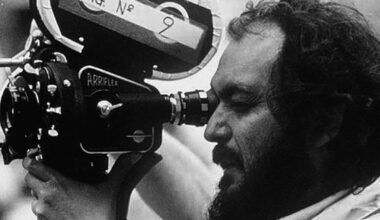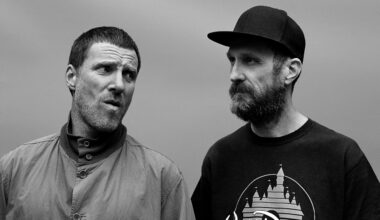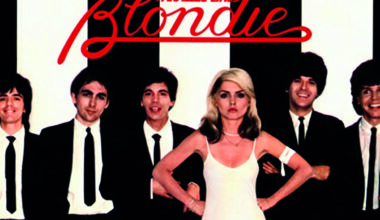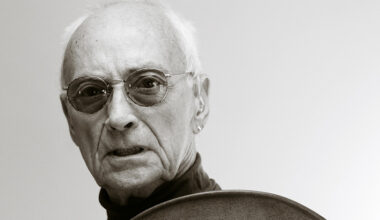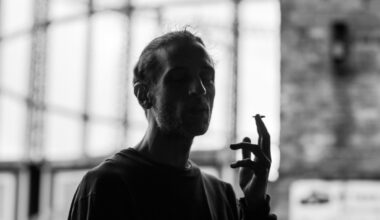For the third part of his psychedelic trilogy, Luke Haines pays tribute to Suicide, Andy Warhol, Lou Reed, William Burroughs and the rest of the red-eyed freaks that stalked the mean streets of 1970s New York
“So the mythological chalk man is rising out of the sand and having a conversation with the birds, who are messengers, and they’re telling him to go to downtown Manhattan. So he does. And he basically freaks out the whole scene.”
Just to recap, that’s a 180-foot chalk figure arising from the Dorset Hills and travelling across the Atlantic with a savant messenger bird called Chico perched on his giant phallus. With Tom Verlaine ringing in his ears, it seems that Cerne Abbas Man is the seeker of mythic muthafuckin’ rock ’n’ roll.
But you haven’t even heard the half of it.
You join us as Luke Haines is explaining the story behind ‘Cerne Abbas Man’ from his excellent new album, ‘New York In The 70s’, a fictitious reimagining of the Big Apple’s music scene between, roughly, 1972 and 1979. It’s the final part of a psychedelic trilogy that started with ‘9½ Psychedelic Meditations Of British Wrestling Of The 1970s And Early 1980s’ in 2011, which is exactly what the title suggests, and last year’s ‘Rock And Roll Animals’, a bedtime tale starring a cat called Gene Vincent, a badger called Nick Lowe and… oh, you know.
In a previous life, Luke Haines was the lynchpin of music press darlings The Auteurs and Black Box Recorder, acts that the passing observer labelled up and tucked away in the box marked “indie”.
So what on earth is he doing sitting pretty in Electronic Sound?
“There has always been an electronic element to my music,” he laughs when his credentials are questioned. “A lot of Black Box Recorder was quite electronic, we wrote ourselves out of playing on the third album [2003’s breezy ‘Passionoia’] because it’s entirely programmed, bar a few guitars. If The Shadows had programming in the 1960s, it would have been that album… It didn’t exactly catch on, that one.”
The Auteurs released a remix EP with intelligent techno innovator μ-Ziq in 1994 and Haines describes his 1996 album under the name Baader Meinhof as “primarily an exercise in digging out old synths and fat old bass stations”. So while he might be joking when he says there’s always been an electronic element to his music…
“I suppose there has,” he says. “You can dig back and it’s all there.”
Border control cleared, passport stamped, welcome to Electronic Sound, Mr Haines.
Thing is, one listen to ‘New York In The 70s’ would have had the same effect as the above light grilling. Synth-packed, bass station-fuelled, drum machine a-go-go, the new record not only crackles with down and dirty electricity, it also demonstrates the one thing Haines has never been short of throughout his nigh on 20-album career – he doesn’t half write a decent tune.
First things first, though. New York in the 1970s? What’s the fascination?
“The genesis of it came when I was at art school,” he explains. “I was a massive Velvet Underground fan so I was reading up about this wonderful existence – you know, the New York Dolls, the Ramones, Suicide – and I’d be walking around Portsmouth at night hoping to find somewhere like CBGBs, Max’s Kansas City or The Factory… Obviously that never happened, but it was more about romanticising it in my head.”
Of course, romanticising only goes so far. New York became a reality for Haines when he visited the city for the first time with The Auteurs in the early 1990s.
“It was just everything I wanted it to be,” he says. “You’re in a yellow cab from the airport and you see signs for Queens and the Bronx, and then you get into Manhattan, which looks just like a Scorsese movie. New York is very aware of its own mythology.”
And others places perhaps aren’t?
“We’re very keen to mythologise Manchester or Liverpool as places where fantastic music comes from, but the Sex Pistols are never described as a London band,” he muses. “And when you get slightly out of London, you’re in this total no-man’s land of rock ’n’ roll mythology, so I thought I’d create an imagined art mythology for the home counties.”
Hence ‘Cerne Abbas Man’. After his visit to New York, the chalk figure goes back to the south of England and tries to recreate a downtown CBGBs scene. Still with us? Good, good. Back on firmer ground, ‘New York In The 70s’ sounds properly great. Analogue gear?
“I do have a collection of old synths,” says Haines. “But I’m no expert, it’s the synthesisers playing themselves really. I’m just twiddling some knobs and hoping for the best. There’s an old Octave Cat, which I’ve used quite a lot, and I like the new gimmicky ones Korg are knocking out at the moment. You can’t really play tunes on them, but they are great for those old noises.”
Ah, the old noises. A steady stream of artists are returning to the past and using electrical instruments you can touch and twiddle and bash. It beats clicking a mouse all day long, right?
“It’s all a bit rickety,” he says. “It’s just me playing everything manually as if it was a band. But the other thing about these old synths, when you’ve got wires all over the place and things bleeping and flashing, it does make your studio look really great.”
‘New York In The 70s’ is essentially a roll call of the good and the great. Sonically satisfying it certainly is, but the lyrics will have you reaching for a friendly search engine and digging around in myriad tales from a very rich vein of rock ’n’ roll history. So rich, in fact, where did Haines even know where to start with this collection of misfits, freaks and loons? Fortunately, inspiration was at hand.
“The idea for the album really came about because I had a song called ‘Alan Vega Says’ hanging around,” he notes.
“Which is based on a true story.”

OK, brace yourselves. John Moore, Luke Haines’ long-time friend and one third of Black Box Recorder, was living in New York’s renowned Gramercy Park Hotel in the late 1980s. One night, he happened on Suicide singer Alan Vega sitting in the hotel bar.
A somewhat messy night ended in Vega’s room, where he had the demos for a new album. Which Vega proceeded to perform. In his underpants. While jumping up and down on the bed.
“I thought, ‘I can get a good song out of this’,” says Haines.
“This album was initially going to be my interpretation of what Alan Vega might have played that night, it was going to be an imaginary Suicide album, but I thought it might get a bit much.
The second track, ‘Drone City’, is exactly that, though.
The idea then expanded to being this whole thing of New York in the 1970s, and so whoever I thought of got a mention.”
The end result comes on like the soundtrack to a prett unhinged musical. Emaciated cast, too much hair, too many black drainpipes, obligatory wraparound sunglasses, loads of jacking up.
Indeed. And why make a sprawling album out of some duty to fill a CD. ‘New York In The 70s’ is 12 tracks, clocking in at a very listenable 33 minutes or so. Made for vinyl, in other words.
“I knew it was going to be a vinyl album when I was making it,” says Haines. “I’ve always thought in terms of side one and side two, and I’ve always been told I had to get out of that way of thinking. I never really understood why.”
The curtain comes down on side one with ‘Bill’s Bunker’. The Bill being William Burroughs, the Bunker being his Bowery apartment in a converted YMCA building. Reach for that search engine. The song? Written from the point of view of heroin going on a journey through Burroughs’ veins. Of course. The closing quartet of tracks on side two is a poles-tucked-under-arms rush to the finish line. The anthemic chant of ‘Lou Reed, Lou Reed’ gives way to ‘UK Punk’…
“It’s about Suicide supporting The Clash in 1976 or 1977 and how UK punk wasn’t ready for them,” explains Haines. “It’s Alan Vega having a conversation with Sun Ra. So the two of them are on Holy Mountain and Sun Ra is saying, ‘Don’t worry, you’re too far out for them. It doesn’t matter, who cares, it’s just The Clash’.”
Then there’s ‘Cerne Abbas Man’, who we’ve met already, followed swiftly by ‘NY Stars’, an emotionally charged, heartfelt tribute. No more, no less. “So rest in peace all my childhood freaks / On imaginary rocket rides /On 53rd and 3rd…”
“If there was a musical, that would be the last number,” admits Haines, seemingly warming to the idea. “It’s me waving bye bye to the greats, thanking them for the endless sea of rock ’n’ roll. I used to be quite cynical about rock ’n’ roll and rock music, now I just worship at the church of it.”
So with the psychedelic trilogy out the way, where next for an over-active mind and a rare talent for expressing it so pleasingly?
“I have just written a micro opera with an artist called Scott King,” he reveals. “I’m doing it at the Berlin Festival this summer. It’s a 20-minute piece about Mark E Smith going on a caravan holiday called ‘Adventures In Dementia’.”
And you still haven’t even heard the half of it.
‘New York In The 70s’ is out now on Cherry Red
“The wrestling album would have made a better musical,” he says. “Better costumes.”
Whoooah. Let’s just roll back a bit there. Jacking up? As you probably already know, 1970s New York was pretty much awash with drugs. Pickled, the whole lot of ‘em. Rather refreshingly, thanks to a ripe sense of humour, the album celebrates the drug behemoths and glorifies their dustbin-sized appetites.
“Absolutely,” confirms Haines. “It’s rock ’n’ roll and that’s what it stands for. I’m happy to accept that humanity is always looking for an altered state. It’s fun to write a blatant drugs song, although obviously the great drugs songs have all been written – The Heartbreakers’ ‘Chinese Rocks’ is perhaps is the greatest, then just pick any Lou Reed song, really. With ‘Tricks N Kicks N Drugs’, I just thought I’d have a crack – no pun intended – at writing a good nihilistic drug chant.”
Everyone who features on the album is such a nailed-on legend, you get the feeling some of the songs wrote themselves once the idea arrived. Take ‘Lou Reed, Lou Reed’. So good they named him twice. Or 68 times…
“I’ve never really written love songs, so that’s my first… to Lou Reed, of all people,” says Haines. “So much has been said and written about him, the only thing left is to just repeat his name over and over again. On ‘Alan Vega Says’, there’s a line about how if you’re in the church of repetition, you’re listening to a master. All rock ’n’ roll is repetition, the three Rs as Mark E Smith once sang – repetition, repetition, repetition. Marc Bolan got it right too when he wrote ‘I love to boogie / On a Saturday night’ and that was about it. That’s the beauty of rock ’n’ roll – life can be distilled into one line. We already have information overload, why add to it?”
Who’s who of ‘New York in the 70s’
Tom Verlaine
Formed Television with old school pal Richard Hell. The band’s 1977 debut ‘Marquee Moon’ pretty much invented new wave. Dated Patti Smith. Makes cucumbers seem a bit warm.
Cerne Abbas Man
Ancient giant figure carved into white chalk rock at Trendle Hill near Cerne Abbas in Dorset. His age and origin remain unknown. The first written reference was in 1694. He has never visited New York.
Velvet Underground
They sparked so little at the time that Lou Reed had to take a $40 a week admin job when he quit the band in 1970. Now one of the most influential groups of all time. Cuh.
Suicide
Electronic trailblazers often mistaken as punk prototypes. Singing by Alan Vega, the rest by Martin Rev. Loathed by many at the time. Live shows were a bit confrontational. Occasionally ended in riots.
Ramones
Songs rarely broke two minutes, gigs no longer than 20 minutes. Resident band at CBGBs from August 1974 until February 1976. Played 2,263 live shows in a 22-year career. Disbanded in 1996.
New York Dolls
The first punk band. Formed in 1971, their drug-fuelled live shows were pretty shambolic. Managed by Malcolm McLaren before he hooked up with the Sex Pistols, who wished they were the New York Dolls.
CBGBS
Legendary Bowery venue synonymous with punk and new wave. Opened by Hilly Kristal in 1973. CBGB stood for “Country, Bluegrass and Blues”. Closed its doors in 2006. Final show? Patti Smith.
Max ’S, Kansas City
Arty hangout frequented by Andy Warhol and the Velvet Underground, who played there regularly before splitting in 1970. A home from home for punk after hiring the CBGBs’ booker in 1975.
The Bowery
Lower Manhattan street, home to CBGBs and a thriving artistic community. Abstract expressionist Mark Rothko had a studio here and you can still see the paint on the floor today.
William Burroughs
American novelist. Prime Beat Generation mover and shaaker. Killed his second wife, accidentally shooting her in the head while drunk. Took a shedload of heroin, wrote some pretty good books.
Sun Ra
Musician, poet, composer, philosopher and total nutjob. Introduced synths into jazz. Claimed to be from Saturn. He went there once, you know. No, he did. Really.
Holy Mountain
A reference to the Alejandro Jodorowsky film ‘The Holy Mountain’, which Luke Haines says is well worth a look, mainly because “it’s fucking nuts”.
53rd and 3rd City
Gritty neighbourhood full of drugs and hookers immortalised in the Ramones’ ’53rd & 3rd’ single, about a male prostitute who kills a punter.

